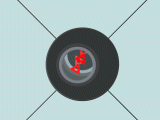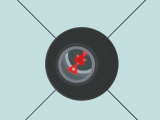 
- Start with the scope "closely" collimated--good diagonal positioning and final Cheshire collimation.
- Carefully "decollimate" the primary mirror only. I suggest the topmost collimation screw or whichever screw allows the primary mirror to gently "tip" forward (or backward--direction isn't important.) The reason I suggest simple tipping motion is to minimize twisting in a sling or other edge support, which may not be as easily "undone" when the primary is recollimated.
 Perform this decollimation with the autocollimator in the focuser to ensure that, as the "ghost" reflections are spread apart, they do not leave the face of the autocollimator. Perform this decollimation with the autocollimator in the focuser to ensure that, as the "ghost" reflections are spread apart, they do not leave the face of the autocollimator.
- Looking in the autocollimator, you will notice that the primary mirror center spot (P) is slightly offset (because the primary mirror has been decollimated.) On either side of the primary mirror spot (P), you will observe a bright upright reflection (1) and a slightly dimmer inverted reflection (2)--flanking the primary mirror center spot (P). The separation between these 2 reflections, 1 & 2, is 8X the actual primary mirror axial error (+/- any residual focuser axial error) induced when the primary mirror was decollimated. For now, you can ignore the flanking reflections. Look carefully at the primary mirror center spot (P) and you should be able to see a second, fainter, inverted reflection (3) either behind or very close to the primary mirror center spot (P).
 Stack the faint, inverted reflection (3) under the primary mirror center spot (P) to form a "Star of David" by adjusting either the diagonal or focuser alignment ONLY. If the focuser is aligned instead of the diagonal, the impact on the primary mirror collimation will be minimized (not eliminated.) However, this is only an issue if the required correction is "significant". Stack the faint, inverted reflection (3) under the primary mirror center spot (P) to form a "Star of David" by adjusting either the diagonal or focuser alignment ONLY. If the focuser is aligned instead of the diagonal, the impact on the primary mirror collimation will be minimized (not eliminated.) However, this is only an issue if the required correction is "significant".
  With P & 3 precisely stacked, go back to the same primary mirror collimation screw you used to decollimate the primary mirror and "undo" the decollimation, watching in the autocollimator as reflections 1 & 2 slowly merge with the primary mirror center spot and 1, 2, & 3 finally disappear from view. With P & 3 precisely stacked, go back to the same primary mirror collimation screw you used to decollimate the primary mirror and "undo" the decollimation, watching in the autocollimator as reflections 1 & 2 slowly merge with the primary mirror center spot and 1, 2, & 3 finally disappear from view.
- Verify the primary mirror collimation with a calibrated Cheshire. If it agrees with the autocollimator--you're done.
  If there is a slight primary mirror axial correction needed, make the correction and reiterate the autocollimator procedure. Now "axial" collimation is fully corrected and you can reevaluate the diagonal positioning if necessary. If there is a slight primary mirror axial correction needed, make the correction and reiterate the autocollimator procedure. Now "axial" collimation is fully corrected and you can reevaluate the diagonal positioning if necessary.
|